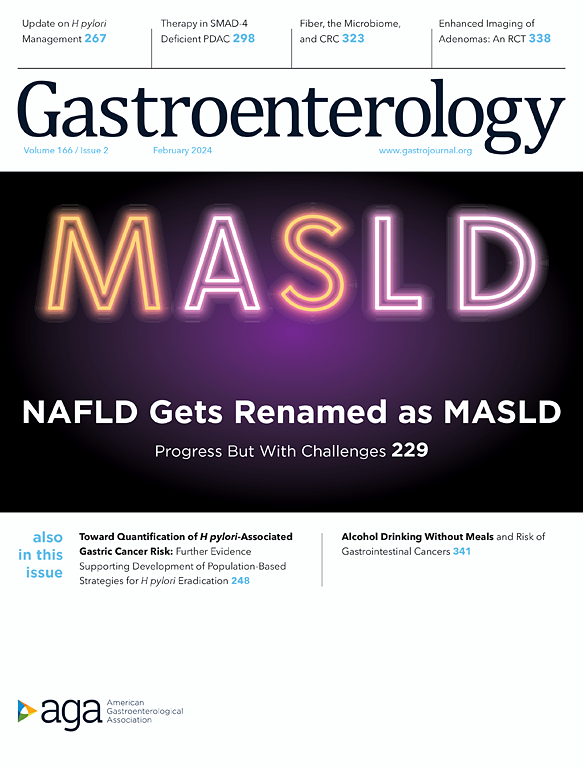缺氧和酸性肿瘤微环境驱动的 AVL9 通过 AVL9-IκBα-SKP1 复合物促进胰腺导管腺癌的化疗抗性
IF 25.1
1区 医学
Q1 GASTROENTEROLOGY & HEPATOLOGY
引用次数: 0
摘要
背景& 目的吉西他滨联合白蛋白-紫杉醇(AG)是治疗胰腺导管腺癌(PDAC)的重要选择。然而,化疗反应相对较差,耐药性发展迅速。本研究旨在探索AG的耐药机制,并开发能使AG方案增敏的策略。方法我们在研究中使用了类器官模型、患者衍生异种移植(PDX)和基因工程小鼠模型(GEMM)。为研究其机制,我们进行了染色质-免疫沉淀(Ch-IP)、双荧光素酶测定、共免疫沉淀(Co-IP)和远西印迹分析。结果通过多策略筛选,我们发现AVL9是PDAC中AG耐药的关键靶点。结果通过多策略筛选,我们发现AVL9是PDAC中AG耐药的关键靶点,其肿瘤促进作用在我们的临床队列中得到了证实。从机理上讲,缺氧相关转录因子 HIF-1α 驱动了 AVL9 的表达。AVL9 可作为支架促进 IκBα 与 SKP1 的结合,从而增强 IκBα 的泛素化和降解,进一步激活 NF-κB 通路。潜在的 AVL9 靶向抑制剂依度他林(Edotecarin)可逆转 PDAC 的 AG 化疗耐药性。AVL9、IκBα和SKP1的物理相互作用为NF-κB通路的异常激活提供了一种新的分子机制。因此,AVL9靶向药物依度他林可能是使PDAC对AG敏感的一种有前途的治疗策略。本文章由计算机程序翻译,如有差异,请以英文原文为准。

Hypoxic and Acidic Tumor Microenvironment–Driven AVL9 Promotes Chemoresistance of Pancreatic Ductal Adenocarcinoma via the AVL9-IκBα-SKP1 Complex
Background & Aims
Gemcitabine combined with albumin-paclitaxel (AG) is a crucial therapeutic option for pancreatic ductal adenocarcinoma (PDAC). However, the response to chemotherapy is relatively poor, with rapid development of resistance. The aim of this study was to explore the mechanism of resistance to AG and to develop strategies that can sensitize the AG regimen.
Methods
We used organoid models, patient-derived xenografts, and genetically engineered mouse models in our study. Chromatin immunoprecipitation, double luciferase assay, co-immunoprecipitation, and far-western blotting analysis were performed to investigate the mechanism. The AVL9 inhibitors were identified through protein structure analysis and molecular docking analysis, and their efficacy was verified in patient-derived xenografts, patient-derived organoids-based xenograft, and KPC models.
Results
Through multistrategy screening, we identified AVL9 as a key target for AG resistance in PDAC. Its tumor-promoting effects were confirmed in our clinical cohorts. Mechanistically, HIF-1α, a hypoxia-related transcription factor, drives the expression of AVL9. AVL9 acts as a scaffold that facilitates the binding of IκBα to SKP1, leading to enhanced ubiquitination and degradation of IκBα, which further activates the nuclear factor–κB pathway. The potential AVL9-targeting inhibitor, Edotecarin, was shown to reverse AG chemo-resistance in PDAC.
Conclusion
AVL9 expression is driven by HIF-1α in PDAC. The physical interaction of AVL9, IκBα, and SKP1 provides a novel molecular mechanism for the abnormal activation of the nuclear factor–κB pathway. Therefore, the AVL9-targeting drug Edotecarin could be a promising therapeutic strategy for sensitizing PDAC to AG.
求助全文
通过发布文献求助,成功后即可免费获取论文全文。
去求助
来源期刊

Gastroenterology
医学-胃肠肝病学
CiteScore
45.60
自引率
2.40%
发文量
4366
审稿时长
26 days
期刊介绍:
Gastroenterology is the most prominent journal in the field of gastrointestinal disease. It is the flagship journal of the American Gastroenterological Association and delivers authoritative coverage of clinical, translational, and basic studies of all aspects of the digestive system, including the liver and pancreas, as well as nutrition.
Some regular features of Gastroenterology include original research studies by leading authorities, comprehensive reviews and perspectives on important topics in adult and pediatric gastroenterology and hepatology. The journal also includes features such as editorials, correspondence, and commentaries, as well as special sections like "Mentoring, Education and Training Corner," "Diversity, Equity and Inclusion in GI," "Gastro Digest," "Gastro Curbside Consult," and "Gastro Grand Rounds."
Gastroenterology also provides digital media materials such as videos and "GI Rapid Reel" animations. It is abstracted and indexed in various databases including Scopus, Biological Abstracts, Current Contents, Embase, Nutrition Abstracts, Chemical Abstracts, Current Awareness in Biological Sciences, PubMed/Medline, and the Science Citation Index.
 求助内容:
求助内容: 应助结果提醒方式:
应助结果提醒方式:


